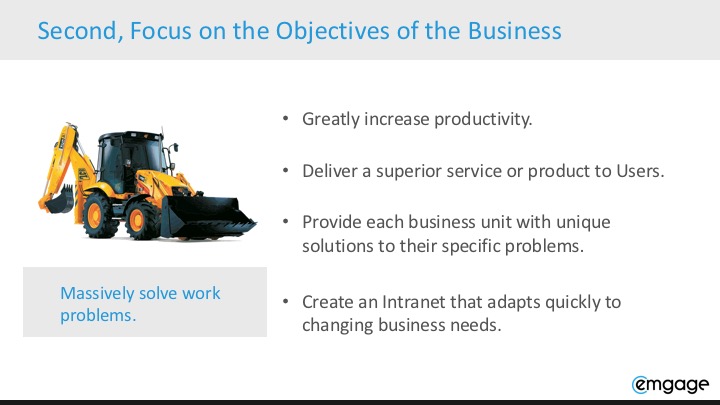Friday, November 11, 2016
Why SharePoint is Still the Ultimate Choice
Friday, October 7, 2016
Free E-Course - Improving your SharePoint Websites Search Rankings
Your SharePoint website should be deserving of an audience. The higher ranked your website is on search engines like Google (for appropriate Search terms) the more your organization will be viewed as a trusted authority.
SharePoint is difficult to optimize for search but it is NOT impossible. In this free, 3-part E-Course on building a SharePoint Site with great SEO Geoff Talbot takes us through the process step-by-step.
Session 1 is recorded below. To take part in additional sessions visit here and sign up.
To watch more webinars from Emgage visit their Work Platform Webinar Center.
Wednesday, September 28, 2016
3 Keys to choosing an Enterprise Software
No one would replace their beat up old Prius with another old Prius if they could access the awesome efficiency of a brand new Tesla. It simply wouldn't make sense.
Yet too many organizations are looking to replace InfoPath with a tool that is exactly the same; a tool that requires hours of coding and IT support. Emgage, has developed the premiere InfoPath Replacement Turbo, a product that sits on top of SharePoint and allows Users to create complex business applications without writing a single line of code.
Watch as Harout from Emgage test drives Turbo in the webinar below.
3 Keys to creating Successful Enterprise Technology
When you are choosing any piece of enterprise technology for your company, there are 3 essential criteria that you should consider.- It should be as natural as possible.
- It should result in a significant decrease in the amount of work required.
- It should have a positive economic impact.
Step 1: As Natural as Possible
Successful enterprise technology should be trending towards making work as natural as possible. This means hiding all the technical elements, putting them behind a wall so to speak, and creating a user interface that is natural and user friendly. One of the primary problems with InfoPath in its current state is that it requires a lot of coding, it typically requires an IT Department to create a form on the Business User's behalf. As a piece of enterprise technology it is not natural to the user, it is not intuitive, it doesn't allow the User to solve their own problems.So what?
As a result then, the process from problem identification (the User says: I need a form to solve this problem) to problem solution (User has a form to solve a problem) is far to convoluted and not natural. The form request has to be submitted to the IT department, where there is often a bottleneck. In the IT department, a person who is unfamiliar with the problem then attempts to create the solution. Again, this takes a long time.

Step 2: A Significant Decrease in Work
A lot of knowledge work is repetitive, so the goal of enterprise technology should be to organize and automate repetitive actions so that the user can work faster and concentrate his or her energy on things that truly matter. When you think of the analogy of a marathon runner who takes 33,000 steps on average to complete a marathon, you can see that the technology, in this case the running shoe, needs to be as light as possible so the runners legs carry very little repetitive weight."If your enterprise technology is too heavy, to work intensive (re:InfoPath), then the knowledge worker will get worn out not only by their work but also by the technology that was designed to assist them, not hinder them."Again, the goal of Turbo from Emgage is to carry the burden for the knowledge worker, providing them with actual solutions that reduce the load of repetitive actions.

Step 3: A Positive Economic Impact
Look at the example of the TESLA and ask: "Why has it been so successful?" Clearly there are several reasons, but one reason that stands out (clearly) is that it has a positive economic impact on a day to day basis for the user. Simply put, it is fully electric and so you do not have to fill up with gas.When you are looking for an InfoPath Replacement, one of the questions you also need to ask therefore is, "what product will have a significant daily, positive economic impact on our bottom line?"In particular with knowledge work and enterprise technology, you must ask, "what kind of technology will reduce the amount of human resource invested in providing a solution?" The fuel that knowledge work typically runs on is "human resource hours," so your goal in looking for the best InfoPath Replacement should be to significantly reduce human resource hours
Summary - Successful Enterprise Technology
The requirements for finding an InfoPath replacement clearly mirror the requirements for acquiring any piece of enterprise software. It should result in easier, more natural work that improves your bottom line.
Collaborative Technologies from Emgage
 Technology that works is bought to you by Emgage Inc, the employee engagement specialists and Industry Leaders whose products Prime and Turbo, significantly solve big work problems.
Technology that works is bought to you by Emgage Inc, the employee engagement specialists and Industry Leaders whose products Prime and Turbo, significantly solve big work problems.
"Collaborative Technologies built to empower the Knowledge Worker"
Why We Exist
We exist to make work more efficient, more productive and more rewarding. Our focus is based around developing collaborative technologies that empower the knowledge worker, helping them to solve real work problems. As consumers, we are all used to engaging with super-intuitive software products and tools from companies like Apple, LinkedIn and Facebook. And yet the moment we enter our office we are often confronted with business solutions that lack the same level of intuition and ease of use. Why is it so easy to update a consumer site or social media channel and yet so frustrating difficult to post a transaction to your accounting system? At Emgage. we're in the business of making Enterprise software simple and easy to use. Interestingly, the problem of poor business software stems from how others go about making such collaborative technologies. Ironically, while trying to create the best collaborative software possible, developers, stakeholders, management and end users are often segregated and don’t understand each other. At other times we get lazy and recycle what worked in the past without questioning if it fits our new needs and paradigms. By the time software is delivered we realize that our requirements have changed but the software is too brittle to flex with these changes. The result is an unintuitive and ineffective software that frustrates users and hurts business productivity.“We believe it is your right to work with business software that does not frustrate and is delightful to use.”Businesses shouldn't have to suffer from decreased employee productivity, simply because they have business applications that do not understand the knowledge workers' needs and how they work. The best collaborative technologies are able to change with you, adapting to solve new problems in creative ways.
 And this is our mission, to drastically improve how organizations create and use collaboration software. Our commitment to this purpose is expressed in our Business Software Bill of Rights as a promise to each and every one of our customer.
And this is our mission, to drastically improve how organizations create and use collaboration software. Our commitment to this purpose is expressed in our Business Software Bill of Rights as a promise to each and every one of our customer.
Great Resources For Intranets
We've put together a number of great resources over the past 12-months to help you increase technology adoption within your organization.- Training Video - Increasing Intranet Adoption
- SlideShare - How to build an Intranet that works
- WhitePaper - Intranet Best Practices - How to create the best Intranets
Great Resources For Websites
We've put together a number of great resources over the past 12-months to help you with your external facing websiteGreat Resources For Business Apps
We're putting together resources that will help you create business applications and forms that allow your Users to create Apps without knowing any code.Tuesday, September 13, 2016
Part 2: Optimizing SharePoint Websites for the Search Engines
Optimizing SharePoint Websites for the Search Engines
Search engine optimization can be broken down into two basic areas.- On-Page Factors - how you tell the search engines to file your content.
- Off-Page Factors - what others are saying to the search engines in regards to your content.
SharePoint Website Optimization - On-Page Factors
SharePoint websites are known to be more difficult to optimize in general because of header codes and inflexible page structures etc. But you should not confuse more difficult with impossible. I like to explain on-page optimization with the following metaphor, scary though it is..."Imagine losing your 4 year-old son or daughter in the worlds biggest shopping mall with over one billion people (there are over a billion websites in the world). Also imagine that you've been told that there is a giant camera, an eye in the sky, that can quickly pass through the crowd, moving through the people extremely quickly as it looks for your child. What kind of information are you going to program into the camera? What kind of information will help them find and identify your child? The more information you give them the more quickly they will be able to find your flesh and blood."The following elements are extremely helpful when it comes to finding anyone:
- Their Name: The Meta-Title of your Content
- Their Address: The Url of your Content
- An Accurate Description: The Meta-Description of your Content
- Distinguishing Features: The Headings in your Content
- Accurate Photos: Alt Tags on the Photos in your Content
- Habits and Particular Idiosyncrasies: The words you use in your copy, particularly in the first and last paragraph.
"When you are optimizing your piece of content, you want to use your targeted keywords to label your piece of content so that the search engines can find it easily and quickly when others are looking for it."To overcome the challenges of optimizing a piece or content on SharePoint, I recommend that you be more aggressive in how you use your keywords. For example:
- Use the Keyword at the very beginning of your Meta-Title and your Meta-Description.
- Create friendly URLs where the keyword is used in the very first part of the variable.
- Avoid keyword stuffing with Meta-Tags. If you use more than 3-5 tags your piece of content maybe down-graded by the search engines.
- Use variations of your keyword at least 5-times in your copy.
- Use at least 3 images and alt tag them with keyword variations.
- Use your keyword in at least twice in your H1 or H2 headings and use this keyword at the beginning of your heading.
SharePoint Website Optimization - Off-Page Factors
As I mentioned at the beginning of this post "off-page factors" are what other websites (including social sites) are saying about your particular piece of content. It may pay to think of off-page factors from this perspective, when no one is talking about your piece of content (linking to it, referring others to it, sharing it on social media), search engines like Google tend to think of it as unimportant. Conversely, when everyone is talking about your web content (Large numbers of links and social shares) then the search engines see your piece of content as being important and perhaps even as an authority regarding your particular chosen keyword subject and they tend to rank you more highly."Again, back to our missing child metaphor at the mall metaphor. Organic search is a form of crowd sourcing in one way, the kind of search where everyone helps the person searching find the "child" that they looking for. Your child is going to be found by the search party much more quickly if members of the crowd are pointing towards where they last saw him or her."

The following elements are extremely helpful when it comes to off-page factors:
- Street Gossip: Social Signals. People sharing your links on social media
- Announcements by Authority Figures: Directory links and links from high quality blogs
- General Help : Links from general blogs.
- Size of your Team: If your website is large and many of your own pages and posts are linked together, then the search engines think of your site as more of an authority and they will rank you more highly.
- Have an aggressive internal link building strategy, where every piece of content links to at least 2 other pieces of content on your site.
- Have an aggressive social sharing strategy that involves a community of likeminded businesses who share each others content on social media (Social Monkee offers this).
- Get your entire site listed in specific directories (like DMOZ).
- Get your content featured on high ranking blogs.
- Have an aggressive blog commenting and community building strategy.
Summary of SharePoint Website Optimization
It is so easy to focus so much on the disadvantages that you face when it comes to optimizing your SharePoint Website that you miss out on the advantages. One of the advantages of building a website with SharePoint is that you can create a very deep and complex site, with multi-level navigation and different site collections.The immense size and complexities of these websites is actually a huge strength when it comes to ranking on search engines like Google. The large numbers of images, pages and posts that you create also offers you another competitive advantage; every optimized piece of content represents another doorway into your business, the more doors you have, the easier it will be for potential customers and clients to find you.
So don't be discouraged, in part 3 of this series next week, I am going to put together a video to demonstrate practically how you can optimize your SharePoint website.
Friday, September 9, 2016
Friday, August 12, 2016
Is SharePoint a Pig?
Wednesday, July 27, 2016
Part 1: Optimizing your SharePoint Website for the Search Engines
The Internet is like the busiest shopping world in the entire galaxy.
Not only are there billions of shoppers there are also over a billion shops or websites (Internet Live Stats). As you can imagine in a shopping mall this busy, it would be very easy for a shopper to get lost, for them not to be able to find exactly what they are looking for. As you can also imagine it is also very easy for "a storefront" to get metaphorically lost, for it to remain hidden and unloved, off the beaten track, stuck behind monster department stores, with no one ever finding you or noticing you.
When you think about your SharePoint Website or Extranet it is imperative that it is not difficult for the "right people" to find you. In fact your website should be incredibly easy to find on big Search Engines like Google. When people are looking for your products or services, you should be the first option provided to them by the Search Engines.
Register for our Free Webinar on Creating and Optimizing SharePoint Website for search on August 9th at 11:00 AM Pacific / 2:00 PM Eastern.
This is not about ego, this is not about been the most popular kid at school, this is 100% about being relevant and about being known as the expert in what you do or provide. Search Engines results are increasingly becoming less about popularity and more of a measure of expertise and authority in the minds of those who search. And this authority is vitally important when it comes to your brand's value and perception.
So the first question, that we must ask when it comes to optimizing your SharePoint Website for the Search Engines is this: What are the areas of expertise and authority, that you wish for your business to be known for more than anything else?

Cutting Your Own Path Through the Forest
At the beginning of this article, I used the metaphor of the Galaxy's Biggest Shopping Mall to describe the Internet, but I would also like to use another metaphor, I'd like to use the metaphor of 'the Biggest Forest you could ever imagine." Making your way through a thick, giant, dense forest is extremely difficult, not only is it easy to get lost, it is actually very difficult and sometimes impossible to move fast.In a dense forest, pathways and tracks are extremely important if you wanting to move at any speed. As you think about optimizing your SharePoint Website or Extranet for search, I want you to think about the dense forest in which you are operating. The best way to help relevant people" find your business in this dense forest is to cut your own path through the forest.
The phrase "cutting your own path," expresses clearly the need for your business to be unique, to be original, to offer a point of difference from all of your competitors. When you are not fighting with your competitors both in business and on the search engines, then you are free to be original and to carve out your own specific niche. "
At Emgage, we like to say, when competition is low, it is extremely easy to win."
Knowing Your Competition Allows You To Avoid Your Competition
One of the first things that we do when it comes to optimizing a SharePoint Website for a client is to analyze the competition. We want to see what they are doing on the Search Engines. We ask questions like:- What is their unique selling proposition?
- Who are your ideal clients or customers.
- Who are your competitors ideal clients?
- How well optimized are their websites?
- Where is their traffic coming from?
- What "search terms" are they targeting?
We analyze your competition so we can help you cut your own path through the dense and murky forest of the search engines; the kind of path that will allow large numbers of relevant people to find you and drink from your well of authority.
Register for Our Free Webinar
Sign up for our Free Webinar on Creating and Optimizing SharePoint Websites and Extranets for search on August 9th at 11:00 AM Pacific / 2:00 PM Eastern.Tuesday, July 26, 2016
Thursday, July 21, 2016
Putting Lipstick On Your SharePoint Intranet
You can put lipstick on a pig, but it is still a pig.
In the same way, you can try your best to make your SharePoint Intranet more attractive. You can try and teach it to behave by transforming it into a "social intranet. You can do a lot of superficial things to increase your Intranet Adoption rate... but at the end of the day, if it was once a pig, it will always and forever still be a pig.
Not that I have anything against pigs.
As a former Veterinary surgeon, I know only to well that pigs are supremely intelligent; they are even very clean, if given the space a pig will designate specific areas for specific activities, one area for eating, one area for the poop and pee, and a separate area for sleeping. But you cannot expect a pig to be anything else other than a pig.
This is not an insult...but...
Your SharePoint Intranet is a pig. It is very smart, highly functional and it can grow very, very quickly. but if you want it to reach its full potential, then you are going to have to stop dressing it in heels and putting lipstick on it. Let her be a pig.

Getting Primal with Your SharePoint Intranet
When it comes to Intranet Adoption it's time to get primal and go back to your piggy roots and asking the hard questions like, "exactly, what is the core purpose of this thing?"
The overarching core purpose of any piece of enterprise software is to make work significantly better for the user. When this happens there is no problem with Intranet adoption.
In fact, low Intranet adoption is a symptom of an Intranet that doesn't solve big work problems for the User. When your employees are not adopting, when they are reticent, they are actually trying to tell you something about the technology... they are trying to tell you that the old way of doing things is still better.
Getting primal with your SharePoint Intranet is the first step in solving your adoption problem and greatly increasing the efficiency and productivity in your workplace.
3 Primal Questions to Ask:
- Where are the sticking points/log jams in work productivity for each of your Users? (You will have to ask them)
- What are 3 ways in which your SharePoint Intranet could make work significantly faster and simpler for each type of User you have?
- Does your current Intranet address these problems and provide significant solutions? If not, why not?
Avoiding the Lipstick
There are a lot of vendors out there, who are promising to put lipstick on your pig. They promise to rebrand your Intranet, give you nifty social tools. and to really get your people talking via your Intranet. This lipstick should fool no one.
Identifying your work problems and creating an Intranet that will truly solve these problems is the process that you must go through if you are truly wanting to use SharePoint Intranet to grow your organization.
One organization that is doing a great job of addressing the deep issues with Intranets is Emgage. I would recommend you check them out and book a demo here.
Thursday, July 14, 2016
What is a Responsive SharePoint Intranet?
No one would bother inventing a black and white only television screen today. In the same way, creating an intranet that is not highly responsive, and that does not work properly on smartphones or tablets is futile.
What is a Responsive SharePoint Intranet?
For Enterprises developing Intranets with SharePoint, it is imperative that their sites look great and work well on mobile. Work is becoming increasingly virtual and increasingly mobile, so if your Users cannot access the valuable resources (via your Intranet) that they need to do their work efficiently from a remote position, then you are going to see their productivity drastically decrease.A responsive SharePoint Intranet is one that works and functions well on a screen of any size. As you can see from the image below, smartphones, tablets and desktops have very different screen sizes and shapes.
The mobile screen is the shape of a typical door and yet your desktop screen is a wide landscape. So the question is how to you design and develop an Intranet that works well and looks great on such different devices?
 Responsiveness isn't a native feature within SharePoint. Read on, and I will give you a really great tip on how you can make this happen without hours and hours of costly coding and development.
Responsiveness isn't a native feature within SharePoint. Read on, and I will give you a really great tip on how you can make this happen without hours and hours of costly coding and development.
The Giant Problem Of A Lack of Responsiveness?
When you think about the phrase "responsiveness" and you think about it in terms of typical human relationships, you will intuitively understand that it is extremely difficult to have a relationship with an unresponsiveness person?This is exactly the issue you will have if your SharePoint Intranet or Website is not responsive. The relationship that your users have to your Intranet will be extremely difficult; when relationships are too difficult people tend to leave (unfortunately sometimes) and look for something else.
If your Intranet or Website doesn't make the work lives of your users significantly better then you are almost certainly going to suffer from a lack of use and user adoption issues.
Take A Giant Leap andMake your Site Responsiveness
While many large enterprises are spending hundreds of thousands of dollars and many months, branding and stylizing their own Intranets there is a much more efficient solution. At Emgage, we've worked really hard to develop a product called Prime that sits on top of SharePoint and makes your Intranet Responsive instantly without the unnecessary and painful sweat of in-house development.In the 21st century, you must be mobile with your Intranet, it must be highly responsive and dynamically powerful... but it doesn't have to cost you the earth. See Prime from Emgage.... they give free Demos
Tuesday, July 12, 2016
Intranet Best Practices. See how to create an Intranet that works

Unpack the best Intranet sites. See how to create an Intranet site that works. Intranet best practices look at exactly what is an Intranet and how to succeed.
https://emgage.com/white-papers/intranet-best-practices-how-to-create-an-intranet
Monday, July 11, 2016
Extinction is Coming --- Meet the New Infopath Replacement
The next on the list to fall into the dark chasm of nothingness is...InfoPath. That's right - InfoPath will no longer be a part of SharePoint come 2023. Not to fret, there are many great InfoPath replacements out there on the market. Before making a final selection, take a couple minutes to ask yourself some questions before settling on a solution. We put together an InfoPath Replacement Checklist to get you through your transition.
Price: What type of budget are you working with? Depending on the scale of your company and overall budget, you may not want to invest a large portion of your budget for replacing InfoPath. Although there are many alternatives out there that are more cost efficient, buying a new solution that is compatible with SharePoint should not be overlooked. Be sure to ask how well your new solution integrates with SharePoint.
Installation: This brings me to my next point. How easily will your new solution be to install? With all the other projects on your desk, the last thing you want to spend time on is another time-consuming installation. Make sure to ask each vendor how quickly you will be up and running.
Intuitive Features: How easy is it to use? The last thing you want to have your end users spending hours trying to figure out how to use a new product. Pick an InfoPath replacement that has intuitive features. Although there are quite a few options for InfoPath alternatives on the market, make sure to purchase one with drag-and-drop features.
Functionality: How functional is your new solution? Make sure you have the same form capabilities with your new product that you had before when you were using InfoPath. Ask specific questions and get technical with your sales rep. When switching to a new product, you want to make sure to be well educated about how a product works.
Mobility: If mobility is not an issue yet, it will be soon. It's time to make sure that your SharePoint site will one day be fully functional. This means your forms will be used on mobile devices on day. Get a running start on enterprise mobility and ask your rep about your possible InfoPath replacements mobile capabilities.
In Conclusion:
As you look to find the most suitable InfoPath Replacement think not only about your needs now but your future needs. The end user is constantly facing new work problems and as such you need a solution that is flexible enough to adapt and solve new problems quickly.Note: This blog was originally published on the Emgage Website





